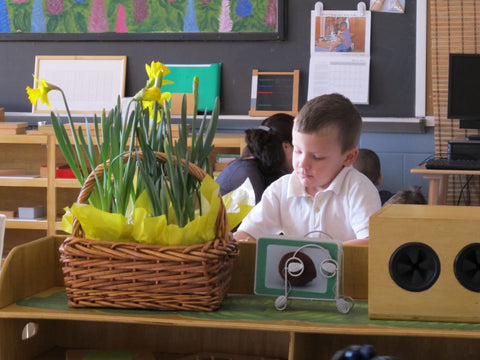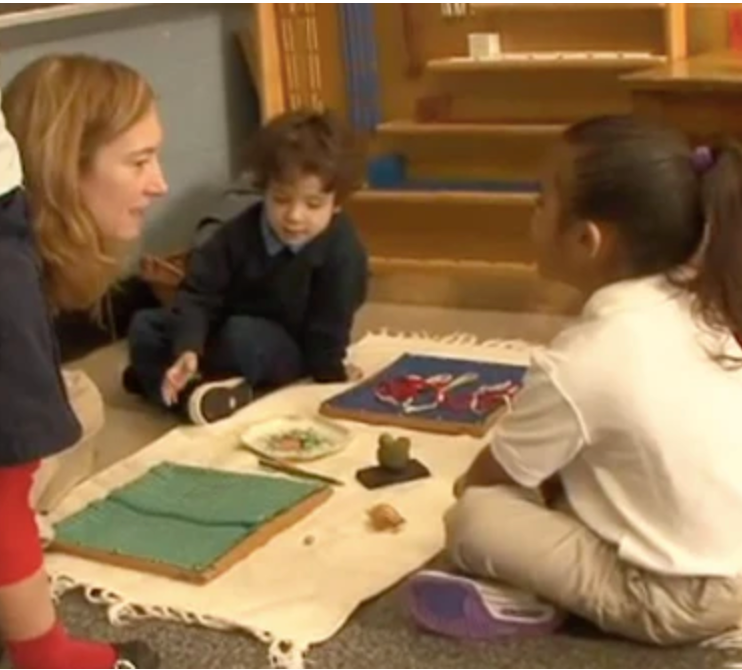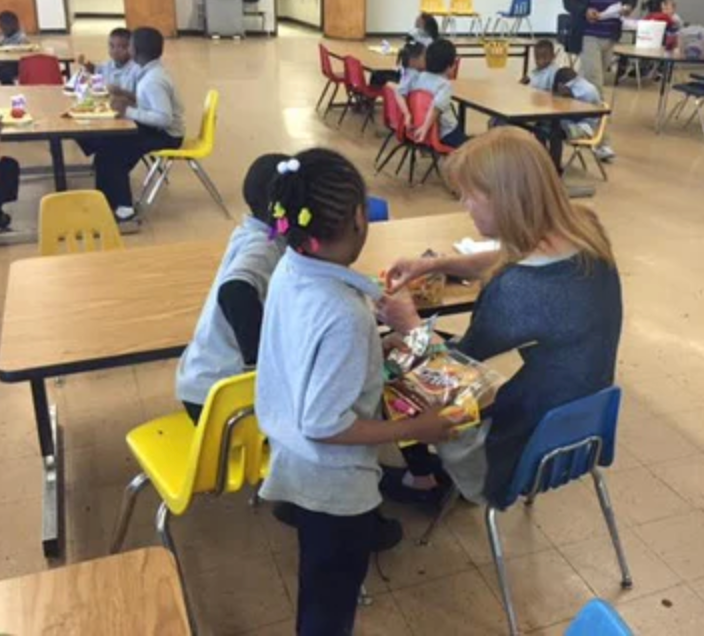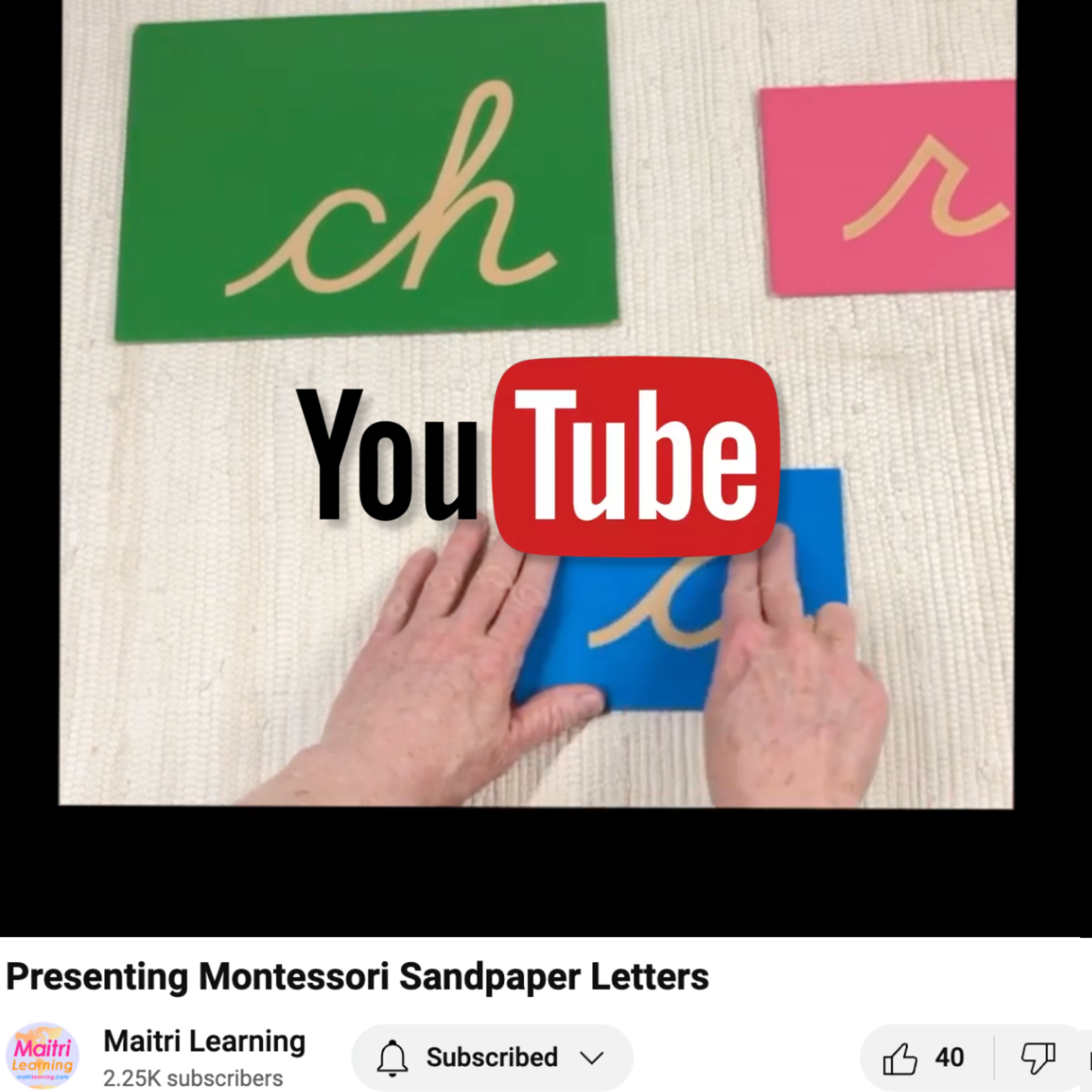What you'll see in a great Montessori school
So, you’re considering a Montessori school. Maybe you’ve read about the growing evidence that supports the long-term benefits of Montessori education. Maybe someone you know enrolled their child in a program and is always pestering you to put your child there. Maybe it’s just an accident (as happened with me) that when you feel your child is ready for school, the closest one to you happens to be a Montessori school. Whatever the reason, when you show up, you want to know that that particular school is a good school.
The Physical Space
Now we can’t all live in the Taj Mahal so the school may not be housed in the most modern building (we all have to start somewhere), but what you should see is that the space has something lovely about it. You’ll have a feeling that someone cared about the entryway, the hallways, the offices, the rooms, and, oh yes, the bathrooms. The walls will not be cluttered or overwhelming. Overall, it will feel calm, inviting, and maybe even elegant.

It may also make you feel like a bit of a giant because the whole school should be adapted to fit the smaller physical bodies of the students it serves. So, you should see benches, chairs, and/or tables that are quite small. Sinks will likely be lowered or the ground raised with solid stools. At all points, there will be a sense of order, care, and intelligence in the physical design.
Observing
Once you’ve walked through the lovely door, the staff at a good Montessori school will make you feel welcome. They will greet you and, even though they will be exceptionally busy, they will make you feel like your visit matters. At some point, they will invite you in to see the classrooms in action. They’ll call this “observing” and in Montessori, scientific observation by the adult is essential.
You see, Montessori teachers are actually all scientists. We are trained to carefully and objectively notice what is going on with each child. We observe how the children use their hands and feet, how they articulate words, how they interact socially with others, how persistent they are in getting what they want, etc. All of these observations are then used by the teacher to customize each child’s curriculum. Every child is allowed to go at their own pace, repeating as often as they need to in order to figure something out.
So on your first visit, you will receive some basic instructions on how to observe. You’ll be asked to enter the classroom very quietly so as not to interrupt the class. You’ll be shown to a chair where you can sit and maybe given a note pad so you can write down your reflections. You are asked to be polite with the children but not to engage with them excessively. Instead, you are to put yourself busily to the task of seeing what’s happening.
...what we really want is for the students to be active and for the adults to be in a support role. It's like each child is the super hero and the teacher is the side kick. We’re the wing man."
Sometimes the school will even give you a sheet with these observation instructions written down. I think every school should put a big caution statement on the top of the observation instruction sheet. “WARNING: Sitting quietly and observing Montessori children without chatting or interfering is sometimes associated with excessive discomfort. Particularly gregarious people may experience mild dizziness, vertigo, or a twitching jaw.”
That’s meant to be a joke but I’m actually serious. Our culture does not teach us to sit back and let children be children. Our culture teaches us that good parents/adults jump in and engage with children and direct them towards doing ‘important things.’ And at this moment, the Montessori school is asking you to go against our culture, sit down, and be quiet. Isn’t that the opposite of what good education is all about?
Actually, when it comes to education, what we really want is for the students to be active and for the adults to be in a support role. It's like each child is the super hero and the teacher is the side kick. We’re the wing man.
The Teacher
The children will most likely be utterly accustomed to having observers visit. A few children may come over to greet you and welcome you to their room. Most will ignore you. Yes, that’s right, you will be less interesting to them than the school work they are doing. There you have it. The next humbling truth of Montessori. The grown up is the least revered thing in the room.
When you finally find the adult in the room, you should notice someone who:
- Precisely and objectively watches the children
- Dynamically engages the children with the hands-on materials
- Models the most gracious, welcoming, and kind behavior you have ever seen
- Demonstrates an insane amount of patience in waiting for the children to speak and get to where they need to go
The Children
In the midst of all this patience rooted in scientific observation, you’ll see a mixed age group of children doing all kinds of things. In a healthy classroom, the children will be quite busy. Some of them will be working by themselves at a table or on a rug. Some will be walking about gathering things or tidying things. Some will be chatting with another child or doing some activity together. Some will be tending to their physiologic needs. And, of course, some will be on the edge of mischief.

The important things to look for in the children is that they seem to be interested in what they are doing and that the work seems to have some logical purpose. They won’t be playing with dolls or toys but will be using real-life materials (like real glasses, pitchers, and bowls) to do intelligent things. You will also usually see a sense of order in what they are doing.
You will also see a mixed age group, generally with a three-year span. So for a primary or preschool/Kindergarten class this would mean around ages 3 to 6. Now the really important thing to notice is that the younger children will look to the older children for guidance and the older children will be happy to offer it. Let me repeat that last part…the older children will be happy to offer help. I’m not even kidding. That is the coolest part of the three-year mixed age group. The older kids get to be leaders. They really flex their “I’m the one who knows how to do this and who can teach others” muscles. It’s gorgeous to watch.
Of course the younger children also benefit tremendously because all humans learn more easily from peers than from authority figures. So, when the new children start coming to school, they will have a whole community of people who can help them learn the ropes, most of whom are about the same size as them.
Concentration
Okay, so all of these things are going on all around us as we take our seat in our observation chair. And, despite the observation instructions, usually the first thing we want to do is start talking with some child or children so we can see what they are doing. We want to strike up a nice little dialogue with one of these perfect Montessori students we’ve heard so much about. I mean, this is our chance to get the inside scoop from the ones who really know what’s going on, right? If we can just talk to the right child, we’ll find out what we really need to know.
Now, resist the urge, step back for a moment, and consider this. In the 21st century, one of the primary goals of education is to develop the capacity to pay attention to what is important and ignore what is not. Everyday, we are immersed in an ocean of information overload. Somehow, we adults have to figure out what doesn’t matter, what does, and then maintain our attention on what does so we can see a task through to completion. So school isn’t just about teaching factual knowledge anymore (although that’s fun and has its place). It’s much more about creating executive function or higher thinking capacities.
So if we succumb to our little bout of curiosity and interrupt a child so we can find out the real dirt on the school, we are actually interfering with the development of that child’s attention span. This is the cardinal sin of Montessori. The big teaching in Montessori is to prepare the environment so children can get what they need, teach the children how to engage with the environment, and then let them have at it! At this point, the adult is careful to fade and observe. If the child needs help, we offer it. If not, we disappear because we know that it is their effort that makes the difference, not ours.
Sit down, relax into your observation chair, and just enjoy what you see. Are the children happy? When there is a conflict or challenge, is it handled compassionately by the teacher and/or the children? Is there a light buzz of meaningful dialogue? Does everyone seem to know what they are doing?
You’ll know if it’s a good school or not because it will make you think…what if the world were like this?"
Really, everything I’ve said above is a distraction. You’ll know if it’s a good school or not because it will make you think…what if the world were like this? What if everyone knew that they had something valuable to do and that they could do it on their own or with others, at their own pace, and get help if they needed it? What if everyone could apply themselves to work that matched their interests and strengths? What if everyone helped to care for the physical environment and helped those in need? These are the questions you will find yourself pondering while you relax into the observation chair of a good Montessori school.
Top photo ©Julia Volkman, 2015; Bottom photo courtesy of Annenberg Learner, Neuroscience & the Classroom, 2012 (www.learner.org/courses/neuroscience)








16 comments
What a great blog! The article outlines what to look for in a Montessori school, emphasizing independence, hands-on learning, and respect.
kidscastle
Amazing insights into what makes a great Montessori school! Loved the focus on hands-on learning, independence, and child-centered education.
simhakidsden
This blog wonderfully explains key elements of a great Montessori school, focusing on hands-on learning, independence, and a nurturing educational environment.
kidscastle
The following post wonderfully explains Montessori education benefits. A great approach to nurturing independence, curiosity, and overall development in children. Very insightful and well-written.
Kids Castle
Wonderful insights into what defines a great Montessori school! It’s inspiring to see the focus on encouraging independence and a love of learning in children. Thank you for sharing.
kidscastle
Wow, this website is amazing! It provides great insights into what makes Montessori schools exceptional. I really appreciate the pictures and easy-to-understand information. Definitely worth exploring!
Kidskastle
Very informative article for anyone who does not know much about Montessori method of teaching. Thanks for sharing!
Gulf Andrabi
@Paula, Hooray! I’m such a fan of your work-I’m just blushing to read your comment. Thank you! And yes, Maggie is amazing. The tiny acts of being Montessorians have great reach…we may never realize the tremendous benefit our actions can bring.
Julia Volkman
@Kate, I think you have hit the nail on the head. Many behavior problems result because children are not placed in a situation where they can independently do purposeful work at their own pace. Guiding them to that meaningful work is the ‘art’ of being a Montessori Guide (not really a teacher at all).
Julia Volkman
Julie, this is such beautiful writing, and you have explained this topic so expertly, I LOVE it! (And Maggie Radzik is one of my favorite human beings, we trained together!)Bravo, and I look forward to reading all your blogs! With admiration, Paula
Paula Lillard Preschlack
I’ve always wondered what it’s like in Montessori schools. I like the view in Montessori schools where teachers are viewed as scientists and notice each child individually and I think I would have liked to have been in a Montessori school when I was in elementary school. I was typically done with my work before my classmates and I would have liked that each child gets their own curriculum based on their pace. I wonder if Montessori school curriculum would fix behavioral problems that can exist in regular schools. http://northendmontessori.com/our-curriculum/lower-elementary/
Kate Hansen
Thanks everyone. I hope it is useful.
@Margery, those are wonderful observations. Thank you for posting!
Julia Volkman
Love the article!
Thank you.
INDU AGNIHOTRI
My grandson has recently started attending a Montessori school in London and last Friday I went to drop him off and look around. Yes I noticed that everything was on a small scale. Everything seemed very structured and all the children were busily engrossed in their activities. As we were leaving I turned to wave goodbye which he acknowledged but then got back into his activity. When we went to pick him up he was pleased to see us and very respectfully said goodbye to his teachers. I was impressed.
Margery Leyden
Exceptionally accurate and beautifully written. I can’t wait to keep up with your blog.
Brittney Maurissa
great work
hana ali
Leave a comment
This site is protected by hCaptcha and the hCaptcha Privacy Policy and Terms of Service apply.